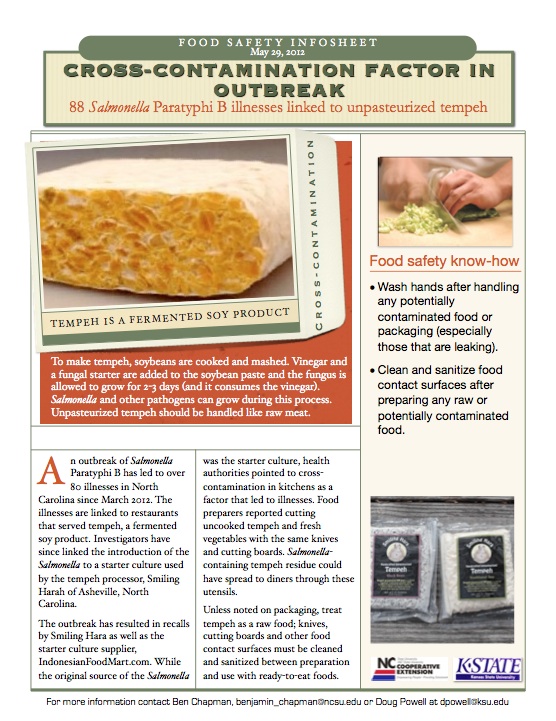A few weeks ago when reports of patrons becoming ill with Salmonella Paratyphi B after eating at Asheville, NC restaurants started appearing on the internet, I didn’t know a whole lot about tempeh production. When epidemiology linked the illnesses to restaurants where Smiling Hara tempeh was handled and prepared, I did a bunch of digging (with the help of some processing colleagues) to learn quick.
To make tempeh, soybeans are cooked and mashed. Vinegar and a fungal starter are added to the soybean paste and the fungus is allowed to grow for 2-3 days (and it consumes the vinegar). Salmonella and other pathogens can grow during this process – meaning unpasteurized tempeh should be labeled as such, and handled like raw meat.
While the prime source of the Salmonella in this outbreak has been linked to the fungal starter, things seemed to get a lot worse for those affected when food handlers prepared ready-to-eat dishes (like salads and garnishes) after cutting up tempeh like it was cheese (which the product kind of looks like).
The newest food safety infosheet, a graphical one-page food safety-related story directed at food businesses, is now available here.
Food Safety Infosheet Highlights:
– Unless noted on packaging, treat tempeh as a raw food.
– Knives, cutting boards and other food contact surfaces must be cleaned and sanitized between preparation and use with ready-to-eat foods.
– Salmonella and other pathogens can grow during the tempeh production process.
– Wash hands after handling any potentially contaminated food or packaging (especially those that are leaking).
Food safety infosheets are created weekly and are posted in restaurants, retail stores, on farms and used in training throughout the world. If you have any infosheet topic requests, or photos, please contact Ben Chapman atbenjamin_chapman@ncsu.edu.
You can follow food safety infosheets stories and barfblog on twitter @benjaminchapman and @barfblog.
